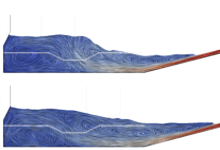HPC User Report from M. Heß (TH-Nürnberg)
Spillway design for small dams
Flood retention reservoirs need to be adapted to take into account the magnitude of the flood peak. For this purpose CFD simulations have been conducted to estimate the hydraulic conditions for an existing spillway and to work out solutions to guarantee its flood safety./strong>
Motivation and problem definition
Due to the latest scientific findings, reported by the Intergovernmental Panel on Climate Change (IPCC), it can be expected, that flooding in summers and winters as well as in transitional periods will become more intense. This depends e.g. on the geographical location and demonstrates even more clearly the negative impacts of climate change. Updated statistics based on recent flood events increase the design discharges for spillways and cause the need to recover the flood safety for those structures. In order to regain the hydraulic effectiveness of the flood retention reservoir Friedrichswalde Ottendorf in the Free State of Saxony (Germany) investigations on three-dimensional hydrodynamic-numerical simulations have been performed.
Methods and codes
 With the usage of the open source CFD-code OpenFOAM®, executed at the LiMa cluster of the Erlangen Regional Computing Center (RRZE), numerical models have been developed to be investigated in terms of hydraulic functionality of the structural variations. Based on the highly turbulent flow conditions in the stilling basin the simulations needed to be performed under the usage of the Large-Eddy-Simulation (LES) method. With this method the large turbulent eddies are being calculated directly and only the smallest turbulent fluctuations are simplified by a modelling procedure. Therefore the claims to the mesh quality are very high and the calculations require huge compute resources.
With the usage of the open source CFD-code OpenFOAM®, executed at the LiMa cluster of the Erlangen Regional Computing Center (RRZE), numerical models have been developed to be investigated in terms of hydraulic functionality of the structural variations. Based on the highly turbulent flow conditions in the stilling basin the simulations needed to be performed under the usage of the Large-Eddy-Simulation (LES) method. With this method the large turbulent eddies are being calculated directly and only the smallest turbulent fluctuations are simplified by a modelling procedure. Therefore the claims to the mesh quality are very high and the calculations require huge compute resources.
Results
 After the calibration and validation of the numerical models using measured values gained at a physical model at the laboratory for hydraulic engineering at the Technische Hochschule Nürnberg the numerical simulations have been conducted. With the highly appreciated compute recourses and support provided by the RRZE the numerical simulations could be accomplished within a tight time schedule. In the result of the investigations a design has been worked out, which improves the hydraulic functionality of the spillway and therefore the flood safety of the flood retention reservoir.
After the calibration and validation of the numerical models using measured values gained at a physical model at the laboratory for hydraulic engineering at the Technische Hochschule Nürnberg the numerical simulations have been conducted. With the highly appreciated compute recourses and support provided by the RRZE the numerical simulations could be accomplished within a tight time schedule. In the result of the investigations a design has been worked out, which improves the hydraulic functionality of the spillway and therefore the flood safety of the flood retention reservoir.
Outreach
The proceeding method as well as the results of the investigations will be presented at the Wasserbausymposium in Graz 2018.
Researcher’s Bio and Affiliation
Max Heß received his master degree in civil engineering at the Technische Hochschule Nürnberg Georg Simon Ohm and is currently working at a scientific assistant at the Institute for Hydraulic Engineering and Water Resources Management of the Technische Hochschule Nürnberg.
